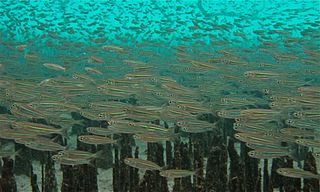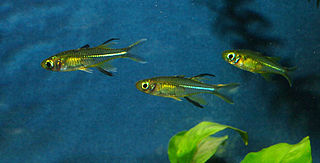
The Atheriniformes, also known as the silversides, are an order of ray-finned fishes that includes the Old World silversides and several less-familiar families, including the unusual Phallostethidae. The order includes at least 354 species. They are found worldwide in tropical and temperate marine and freshwater environments.

USS Silversides (SSN-679), a Sturgeon-class attack submarine, was the second ship of the United States Navy to be named for the silverside, a small fish marked with a silvery stripe along each side of its body.
The Old World silversides are a family, Atherinidae, of fish in the order Atheriniformes. Atherinidae are abundant and considered bony fish (teleost) that are widespread globally, living in rivers, estuaries, and coastal waters. They occur worldwide in tropical and temperate waters. About two-thirds of the species are marine, and the remainder live in fresh water. The 74 species are in 13 genera. The genus Craterocephalus is the most diverse with 25 species. Four genera are monotypic.

Atherinomorus is a genus of silversides in the family Atherinidae.

The hardyhead silverside, also known as the broad-banded hardyhead, broad-banded silverside, Capricorn hardyhead, pitted hardyhead, robust hardyhead, robust silverside, slender hardyhead and wide-banded hardyhead silverside, is a silverside of the family Atherinidae. It occurs in the Indo-Pacific near the surface as well as in the Mediterranean, having invaded as a Lessepsian migrant through the Suez Canal.

The lined silverside is a species of fish in the family Atherinidae. It is found in Indonesia and the Philippines. This species was described as Atherina lineata by Albert Günther in 1872 with the type locality given as Cebu.
The Key silverside is a species of fish in the family Atherinopsidae:Menidiinae. It is endemic to the Florida Keys.
Poblana is a genus of Neotropical silversides that are endemic to Mexico, with each of the four threatened species restricted to a single Oriental Basin maar lake. They are small fish that do not surpass 8 cm (3 in) in standard length.

The Celebes rainbowfish is a species of sailfin silverside endemic to Sulawesi in Indonesia. It is the only known member of its genus.
Teramulus kieneri, the Keiner's silverside or vily, is a species of silverside endemic to Madagascar where it is found in rivers around on the eastern coast. This species was described by J.L.B. Smith in 1965 with the type locality given as the coastal swamps near Tamatave. It has since been found in other areas of the island, including the basin of the Nosivolo River and in the Bemarivo River. Smith gave this species the specific name keineri to honour the French fisheries scientist, André Kiener, who assisted in the collection of the type in 1961, although it was initially reported as Atherinomorus duodecimalis. It is the type species of the genus Teramulus.
The Waccamaw silverside is a rare species of fish in the family Atherinopsidae. It is a federally listed threatened species of the United States.
Hardyhead refers to a number of species of fish in the family Atherinidae, including:

Labidesthes sicculus, also known as the Brook silverside is a North American species of Neotropical silverside. The brook silverside lives in slow moving rivers and lakes from the Great Lakes to the Mississippi Basin and Gulf Coastal Plains. The brook silverside survives best in clear water with aquatic vegetation. L. sicculus feeds on a diet of copepods, insect larvae, and winged insects. The spawning season of the brook silverside occurs during the spring and early summer. The survival of freshwater fishes such as the brook silverside is increasingly threatened. In order to ensure survival of the brook silverside, turbidity of natural habitats should be monitored.
Iso is an Indo-Pacific genus of silversides, commonly called surf sardines, the only genus in the monogeneric family Isonidae, they were formerly classified in the family Notocheiridae alongside the surf silverside but they are now thought to be within the suborder Atherinoidei while the surf silverside is classified in the suborder Atherinopsoidei, along with the Neotropical silversides. It contains five species to date, the first of which was described in 1895.

The Hawaiian cleaner wrasse or golden cleaner wrasse, is a species of wrasse found in the waters surrounding the Hawaiian Islands. The fish is endemic to Hawaii. These cleaner fish inhabit coral reefs, setting up a territory referred to as a cleaning station. They obtain a diet of small crustacean parasites by removing them from other reef fish in a cleaning symbiosis.
Membras martinica, the rough silverside, is a species of Neotropical silverside from the family Atherinopsidae, it is the type species of the genus Membras.

Atherinomorinae is a subfamily of silversides from the family, Atherinidae, the Old World silversides.
Atherinomorus aetholepis is a species of Old World silverside native to the western Pacific.

The belted wrasse is a species of wrasse in the family Labridae, endemic to the Hawaiian Islands. It was originally named Stethojulis axillaris by Quoy and Gaimard in 1824. In Hawaiian, this species is known as ʻOmaka, although it may also be referred to as hīnālea or alea, for wrasse.








